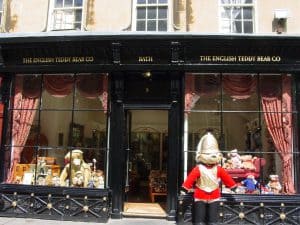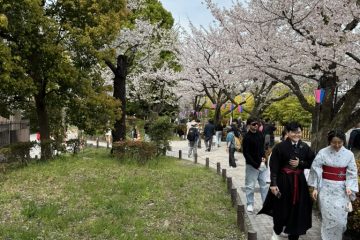Our first leg of this trip was to be the city of Bath, known for its ancient Roman baths, fed by hot springs. We will spend a day here to overcome any jet lag. The next day we will pick up a rental (hired) car. We had thought about using the rail system, but there were things that we wanted to see outside the cities and towns and a car made sense.
After a long transatlantic flight, we arrived in London/Gatwick. We knew when traveling east we needed to sleep on the way to avoid jetlag. We tried, but someone (Daryl) kept kicking the back of our seats. We had not been able to get seats together for the flight, but he was able to get behind us and while we tried to sleep, he was kept awake by the woman next to him. She was trying to sleep herself and kept snuggling to him, keeping him awake and “if I can’t sleep, no one will” was his attitude. Needless to say, we arrived tired. After landing, we boarded the train for the trip out to Bath.
Bath
Bath is the largest city in the ceremonial county of Somerset, England. It is an Abbey, the Roman Baths, a residential area called the Royal Crescent and so much more.
We arrived around 10am. We were advised to get a taxi to get to the Marlborough House where we were staying. The line/queue for the taxi’s was quite long, so we decided we’d leave the train station and just hail a cab from the street. None stopped. We were hungry, so we looked around to find a place to eat breakfast.
We ended up in a hotel’s pub and they did not mind us bringing in our luggage. We sat down and the waitress came over to get our drink order while we perused the menu. Teresa asked for a root beer. The waitress looked puzzled and left and when she returned, she asked Teresa if she wanted a pint. Teresa said something like, “If that’s how it comes, sure” and the waitress left. Daryl and I looked at each other and smiled and sure enough, the waitress returned with a pint of beer for Teresa.
After breakfast the bell captain hailed us a cab, after informing us that a cabs cannot be hailed from the street. We packed up and headed for the Marlborough House.
Marlborough House BnB
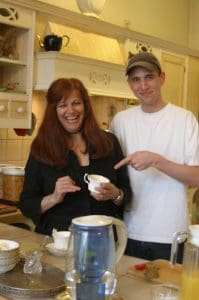
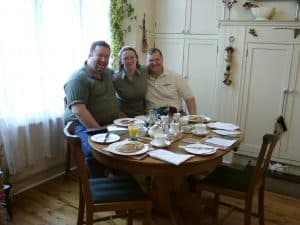 Marlborough House is double 4 Star Gold Award rated establishment operated by Peter Moore in a friendly and informal style. It is conveniently close to all of Bath’s famous attractions, including the Royal Crescent, Roman Baths, Thermae Spa and fantastic shopping and dining opportunities. They also are very vegetarian friendly, which made Teresa very happy… Daryl, not so much so. We arrived and were exhausted. We decided to crash for an hour or two before setting out.
Marlborough House is double 4 Star Gold Award rated establishment operated by Peter Moore in a friendly and informal style. It is conveniently close to all of Bath’s famous attractions, including the Royal Crescent, Roman Baths, Thermae Spa and fantastic shopping and dining opportunities. They also are very vegetarian friendly, which made Teresa very happy… Daryl, not so much so. We arrived and were exhausted. We decided to crash for an hour or two before setting out.
We went out and walked around the historic part of Bath. Daryl was not happy about all the walking, but we had warned him and while we were grateful to be slower, we were excited because of everything we were going to see.
Our first stop was just up the street, the Royal Crescent. The Royal Crescent is a row of 30 terraced houses laid out in a sweeping crescent in the city of Bath, England. Designed by the architect John Wood, the Younger and built between 1767 and 1774, it is among the greatest examples of Georgian architecture to be found in the United Kingdom.

From there, we walked to the bridge and shopping areas. Some of the streets were narrow, with signs and lights overhanging the sidewalks or pedestrian ways. Some of the shops were campy and touristy while others were tasteful. We had a guide book, and new some of the sites we wanted to see.
One of the places we wanted to see was the Sally Lunn Eating House. We had heard many stories of hot-crossed buns and this is reportedly one of the origins or inspiration of the nursery rhyme.
Sally Lunn Eating House
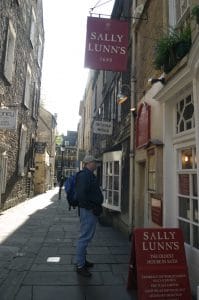 The medieval building now known as the Sally Lunn Eating House is at 4 North Parade Passage (formerly Lilliput Alley) in Bath. The site was originally occupied by the south range of Bath Abbey and the lowest floor level dates to the reconstruction of the abbey after a great fire in 1137. The masonry oven in the basement dates from this time. After the Reformation it came into the hands of the Colthurst family of Wardour Castle who sold it to John Hall of Bradford on Avon in 1612. In 1622 Hall leased the site to George Parker, a carpenter who built the current house. The Hall estate was later acquired by the 2nd Duke of Kingston, who sold the house to William Robinson in 1743. There may have been baking on a small scale during the 1700s but it only became the main commercial use of the building around the turn of the century.
The medieval building now known as the Sally Lunn Eating House is at 4 North Parade Passage (formerly Lilliput Alley) in Bath. The site was originally occupied by the south range of Bath Abbey and the lowest floor level dates to the reconstruction of the abbey after a great fire in 1137. The masonry oven in the basement dates from this time. After the Reformation it came into the hands of the Colthurst family of Wardour Castle who sold it to John Hall of Bradford on Avon in 1612. In 1622 Hall leased the site to George Parker, a carpenter who built the current house. The Hall estate was later acquired by the 2nd Duke of Kingston, who sold the house to William Robinson in 1743. There may have been baking on a small scale during the 1700s but it only became the main commercial use of the building around the turn of the century.
The building was acquired in the 1930s by Marie Byng-Johnson who opened it as a tea-room specializing in Sally Lunn buns, promoted with a story that she had discovered an ancient document in a secret panel above the fireplace explaining that Mlle. Sally Lunn was a young French Huguenot refugee who brought the recipe to Bath around 1680.
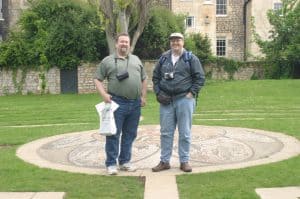
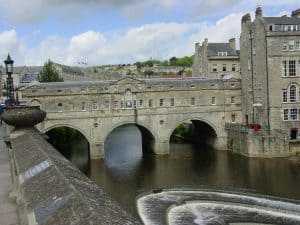 We walked for hours, finally getting to the Abby. The Baths were just around the corner (or so we told Daryl). The abbey was a photographers paradise. We spent a lot of time there, reading the tombstones, listening to the tour guides as they passed us and just enjoying the beauty.
We walked for hours, finally getting to the Abby. The Baths were just around the corner (or so we told Daryl). The abbey was a photographers paradise. We spent a lot of time there, reading the tombstones, listening to the tour guides as they passed us and just enjoying the beauty.
Abbey Church of Saint Peter
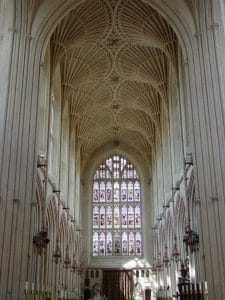 The Abbey Church of Saint Peter and Saint Paul, Bath, commonly known as Bath Abbey, is an Anglican parish church and a former Benedictine monastery and a proto (former) Co-cathedral in Bath, Somerset, England. Founded in the 7th century, Bath Abbey was reorganised in the 10th century and rebuilt in the 12th and 16th centuries; major restoration work was carried out by Sir George Gilbert Scott in the 1860s. It is one of the largest examples of Perpendicular Gothic architecture in the West Country. The cathedral was consolidated to Wells Cathedral in 1538 after the abbey was dissolved in the Dissolution of the Monasteries, but the name of the diocese has remained unchanged.
The Abbey Church of Saint Peter and Saint Paul, Bath, commonly known as Bath Abbey, is an Anglican parish church and a former Benedictine monastery and a proto (former) Co-cathedral in Bath, Somerset, England. Founded in the 7th century, Bath Abbey was reorganised in the 10th century and rebuilt in the 12th and 16th centuries; major restoration work was carried out by Sir George Gilbert Scott in the 1860s. It is one of the largest examples of Perpendicular Gothic architecture in the West Country. The cathedral was consolidated to Wells Cathedral in 1538 after the abbey was dissolved in the Dissolution of the Monasteries, but the name of the diocese has remained unchanged.
The church is cruciform in plan, and able to seat 1200. An active place of worship, it also hosts secular civic ceremonies, concerts and lectures. Its congregation numbers in the hundreds, and annual visitors in the hundreds of thousands. The choir performs in the abbey and elsewhere. There is a heritage museum in the vaults.
Night came and we found a place to eat before heading back to the BnB. The next day was going to be the Baths and exploring.
The next morning, we got up for breakfast. We had been exhausted and slept well. Our hosts had some wonderful options and it was very good. They told us about more sites and gave us some tips about touring the Roman baths. Daryl told us he was going to venture out on his own. Today was our anniversary and he wanted us to have some time on our own. He said he’d catch up with us later.
We made it to the Baths and I was amazed at how the Romans engineered the facility. It was remarkable to see that much of the plumbing and ducts were still working.
Roman Baths
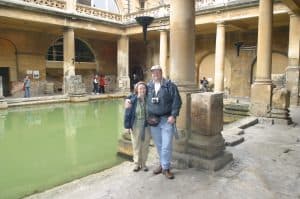 The Roman Baths complex is a site of historical interest in the English city of Bath. The house is a well-preserved Roman site for public bathing.
The Roman Baths complex is a site of historical interest in the English city of Bath. The house is a well-preserved Roman site for public bathing.
The Roman Baths themselves are below the modern street level. There are four main features: the Sacred Spring, the Roman Temple, the Roman Bath House and the museum, holding finds from Roman Bath. The buildings above street level date from the 19th century.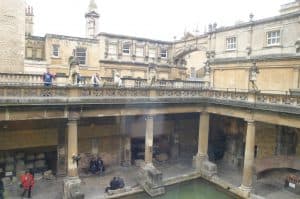
The Baths are a major tourist attraction and, together with the Grand Pump Room, receive more than one million visitors a year. Visitors can see the baths and museum but cannot enter the water.
We met up with Daryl that night. We shared what we saw. He had gotten a double decker tour bus day pass. It was one that he could hop off at one location and hop on the next bus that came around. I could not imagine Daryl hopping off, and he confirmed that when he grumbled that most every stop we stopped at was someplace we had dragged him to the day before, on foot.
We retired to our rooms for the night. Tomorrow was going to be Stonehenge.
We got up the next morning, a little sore but no worse for wear. We went down for breakfast and were talking about our plans to rent (hire) the car and go out to Stonehenge. Our hosts let us know that while Stonehenge was nice, there was another lesser known stone circle nearby. At Stonehenge, you cannot walk up to the stones and touch them, while at the other site, you could. So they gave us directions to Avebury. We took off to get the car.
Car Rental
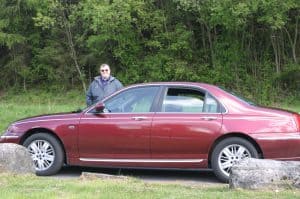 Now before we left, we had research travel and whether to take the Euro-rail system or to get a car. Both had their appeal, and both had their disadvantages. We also checked out insurance and driver requirements. Did we need extra insurance? No. Did we need an international driver’s license? No. We decided that renting a car would be better.
Now before we left, we had research travel and whether to take the Euro-rail system or to get a car. Both had their appeal, and both had their disadvantages. We also checked out insurance and driver requirements. Did we need extra insurance? No. Did we need an international driver’s license? No. We decided that renting a car would be better.
(Note: These requirements may have changed, please do you own research.)
So after signing all the rental agreements and contracts, we proceed to the lot. The car is a Range Rover sedan and has plenty of room for us and our bags. Being the driver, I walked to the left side and opened the door. It was habit. I had to walk around. We all got in the car and started giggling and then right out loud laughing. Just over a week and a half. Would I get used to this? Both Teresa and Daryl did not even want to try driving, so it would all be on me. I knew that pulling off the lot would require me to concentrate, to mentally focus on which way to look first, on which lane to get into AND since the lot opened onto a one-way street and intersected with a round about, just HOW to navigate this. I started laughing again, this time from nerves and it was contagious. I swear we did not move for 30 minutes.
Driving in the becomes autonomous, you rarely think about it. Sure, your brain is aware when things go wrong, but the act of driving is almost automatic. Think about the drive to work, the same way every day and you could almost do it in your sleep. But on the weekend, take a trip to the store, someplace off the route and you miss your turn and your subconscious had taken over. Now get into a car with the steering wheel on the other side, the lanes on the other side and the turns go the other way and you will find that you have to focus. It is tiring to have to concentrate for that long. Still, it was worth it.
Stonehenge and Avebury
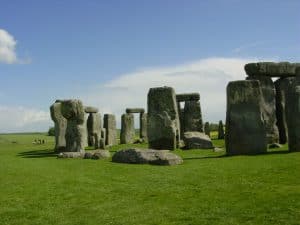 We drove out to Stonehenge and were directed to the parking area. It was windy and cold, but still was amazing to see. Like we were told though, the monument is fenced off. Only twice a year do they allow visitors in and this was of one of them.
We drove out to Stonehenge and were directed to the parking area. It was windy and cold, but still was amazing to see. Like we were told though, the monument is fenced off. Only twice a year do they allow visitors in and this was of one of them.
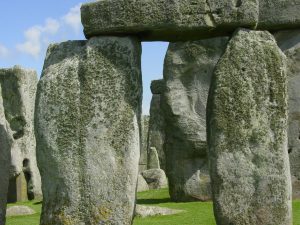 Stonehenge is a prehistoric monument in Wiltshire, England, 2 miles (3 km) west of Amesbury. It consists of a ring of standing stones, with each standing stone around 13 feet (4.0 m) high, 7 feet (2.1 m) wide and weighing around 25 tons. The stones are set within earthworks in the middle of the most dense complex of Neolithic and Bronze Age monuments in England, including several hundred burial mounds.
Stonehenge is a prehistoric monument in Wiltshire, England, 2 miles (3 km) west of Amesbury. It consists of a ring of standing stones, with each standing stone around 13 feet (4.0 m) high, 7 feet (2.1 m) wide and weighing around 25 tons. The stones are set within earthworks in the middle of the most dense complex of Neolithic and Bronze Age monuments in England, including several hundred burial mounds.
After some time, we decided we wanted to see this Avebury and went back to the car. Again, I went to the wrong side, but held the door open for Teresa (ya, I meant to do that…uh huh).
It was a short drive, less than an hour with several turns and roundabouts.
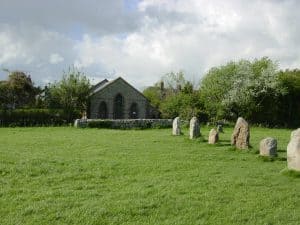 Avebury is a village and civil parish in Wiltshire, England. The village is about 5.5 miles (9 km) west of Marlborough and 8 miles (13 km) northeast of Devizes. Much of the village is encircled by the prehistoric monument complex also known as Avebury. The parish also includes the small villages of Avebury Trusloe and Beckhampton, and the hamlet of West Kennett.
Avebury is a village and civil parish in Wiltshire, England. The village is about 5.5 miles (9 km) west of Marlborough and 8 miles (13 km) northeast of Devizes. Much of the village is encircled by the prehistoric monument complex also known as Avebury. The parish also includes the small villages of Avebury Trusloe and Beckhampton, and the hamlet of West Kennett.
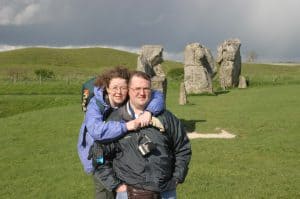 The Avebury monument is vast, and consists of several smaller sites of varying dates. The earliest of these, the earthworks, dates to between 3400 and 2625 BC. Later additions include a henge and several stone circles. Starting in around the 14th century locals began dismantling the stone circles for one reason or another, to clear land, to provide material for other building projects, or simply to efface a pagan monument.
The Avebury monument is vast, and consists of several smaller sites of varying dates. The earliest of these, the earthworks, dates to between 3400 and 2625 BC. Later additions include a henge and several stone circles. Starting in around the 14th century locals began dismantling the stone circles for one reason or another, to clear land, to provide material for other building projects, or simply to efface a pagan monument.
We spent hours here. The wind was strong and cold; we even took shelter from a small hail/snow storm. Still, it was amazing to walk among the stones, to touch them, close our eyes and picture what might have been. At the visitor’s center, we learned that two “henge” intersected and that there was been a human settlement in the intersection since before written history.
We were watching the time. We knew we were running a bit over, but still had some leeway built into the schedule. We got back to the car and hit the road, towards Beddgelert.
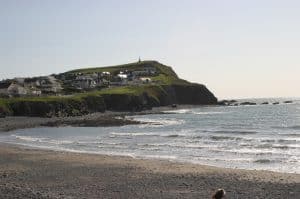
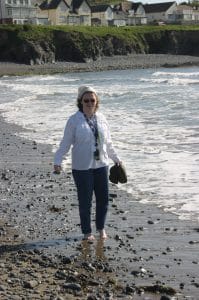 Along the way, we found ourselves driving through a coastal town. Well, Teresa had to get out and put her feet into the (coooold) water.
Along the way, we found ourselves driving through a coastal town. Well, Teresa had to get out and put her feet into the (coooold) water.
And we were off again, to the sleepy town of Beddgelert.

